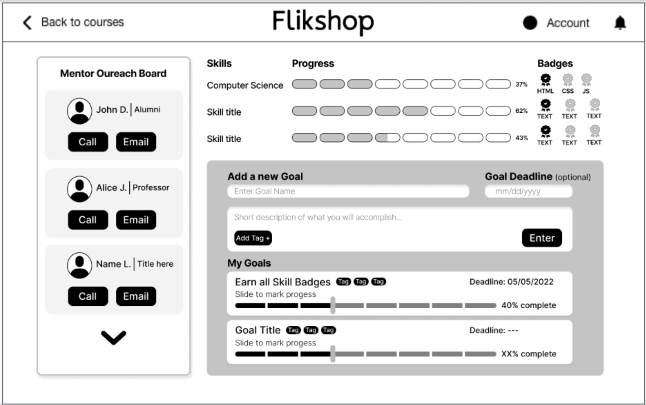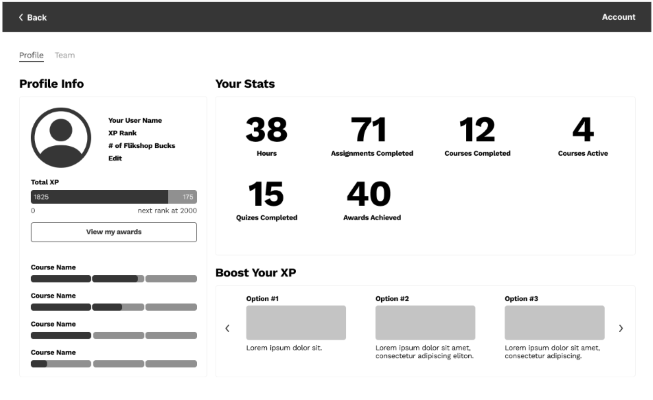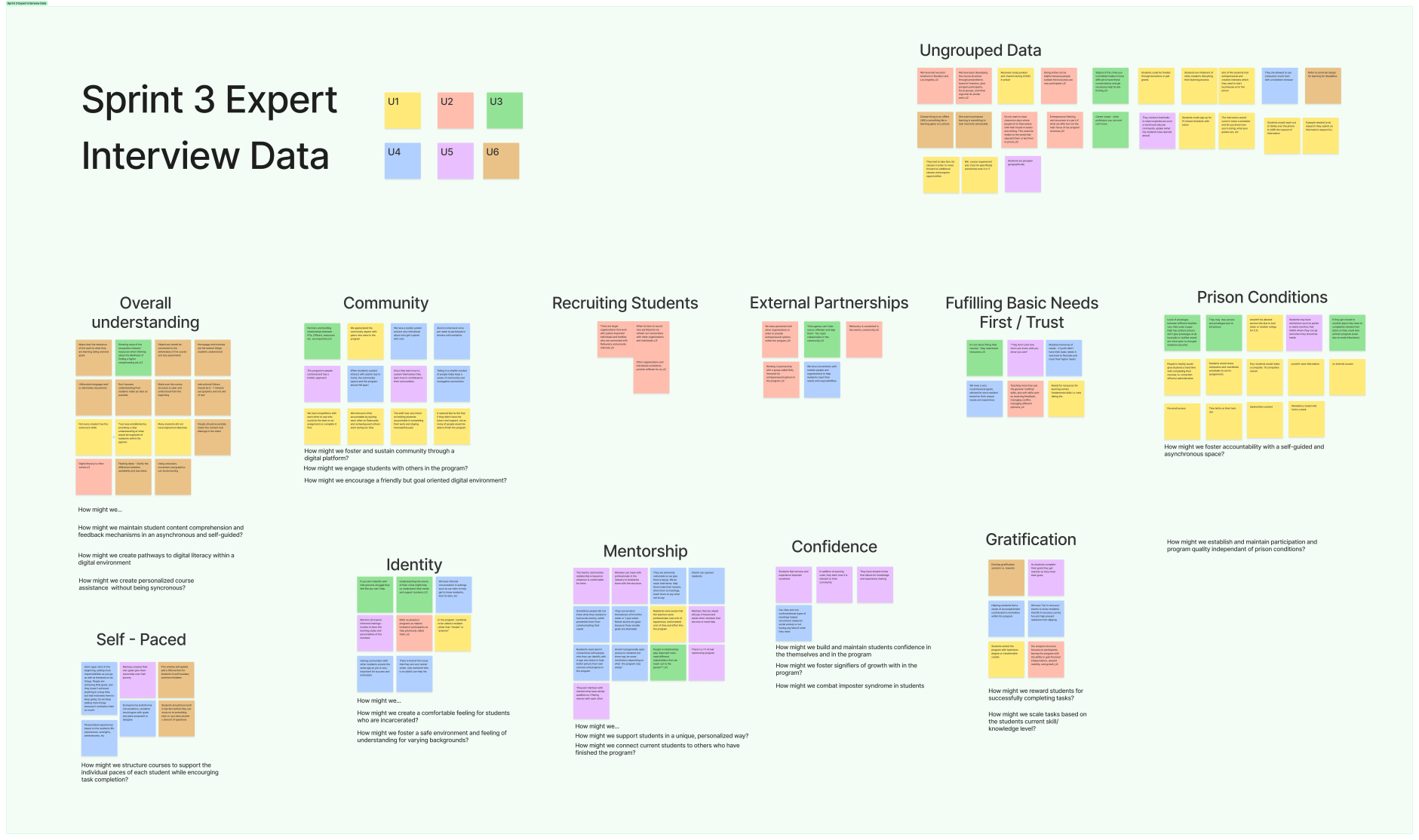Sprint 3: Understanding and Leveraging Motivation
Research Question: How might we amplify and support students’ personal motivations through FlikshopMe?
Expert Interviews
For this sprint, understanding user needs and experiences was critical to the success of the team because our understandings of the project space were so varied. We interviewed 5 people with different skills and experiences. Our users are as follows:
Activities Directors with Similar Goals
Alumni of Goucher Prison Education Program
Executive Director of Substance Abuse Recovery House
Digital Learning Expert
Motivation
- Students will be more motivated when they understand what the course requires from them, exactly what they are learning, and how those learnings feed into their personal goals
- Feeling a sense of accomplishment helps propel students to keep going
- Gratification and rewards pushes students when they lack intrinsic motivation
Community
- Students trust their instructors if they feel like they can relate to each other
- Mentorship builds students’ confidence and provides accountability
- Students who worked with others felt that was critical to their success
Identity
- A student’s personal identity can either support or hinder academic success
- Incarcerated students often have low confidence about their ability to perform academically
- If a student’s basic needs are not met, they will face difficulty in fulfilling the higher needs.
Persona Building
Based on our interviews, we created basic persona types, one older user and one younger. Our client was concerned that one of our personas seemed much more advantaged than the other, yet that student was described as having lower motivation. Our client also mentioned that the target audience would likely be a younger demographic that may still experience many of the challenges we outlined for the older student. We kept this in mind as we moved forward.
John

Age: 31
Time Completed: 10 out of 12 years
Education: Some highschool
Goals:
John’s interests and goals are motivated by his awareness of the current integration of technology in society and wanting to be able to have a good start when trying to join the tech field and avoid the possibility of reincarceration.
Improve Tech Literacy
Gain employment
Learn how to code
Obstacles:
- Imposter syndrome
- Not confident in his technology abilities
- Apprehensive to start something new.
- Learning how to learn.
Mike

Age: 18
Time Completed: 1 out of 5 years
Education: Highschool Grad
Goals:
Michael’s interests in the Flikshop program are influenced by his desire to complete his sentence as soon as possible and then turn is life around.
Find direction for his life
Pass the time
Stay out of trouble
Obstacles:
- Feels like an outsider due to age
- Loses motivation easily
- Wants a role model
- Not self disciplined
Product Concepts
Each team member developed a sketch and then the team voted on the top three ideas. We split into three groups of two to explore these ideas and then presented them to our client for a decision.
1. Character Guide (Markus and Kayla)
This concept gives the user periodic instruction, tips, and encouragement through pre-loaded feedback from the instructor. While it would not be custom, this feedback would be tailored to the user and their learning experience. For example, if a person keeps clicking a wrong answer, a not would appear that would explain the most common misconceptions that may lead to choosing that answer/

Receive encouraging feedback between lessons

Instructor tips are displayed at key moments in the learning process
Pros
- Encourages content exploration and individual learning
- Motivates and directs students if confused or lacking motivation
- Provides application based learning with necessary asynchronous guidance
- Allows students to see people like themselves represented
Cons
- Comments may feel insincere
- Could be annoying
- Interruptions could interfere with student flow
2. Gamification (Ghayas and Bree)
This concept focuses in on gamification. The user is represented as an avatar that creates their personal journey map by choosing what kinds of activities they complete. The user sets goals and views their progress toward those goals. As they complete lessons and courses that bolster their skills, they are able to monitor their skills by viewing their skills progress bars and badges. This concept also connects users with mentors.

Users create a game-like student journey that maps their experience.

Students can reach out to mentors, create goals, and view their skills
Pros
- Creates a personable experience
- Allows the students to branch out, and have access to trusted mentors for help
- Users get a sense of gratification by earning points and badges
- Users see they are working toward something greater and remain engaged
Cons
- Using an animal such as a penguin to represent the user is too juvenile for the target audience.
- Accessing mentors would be challenging
- Users need more direction in formulating goals
3. Competition (Alea and Matt)
Many of our users spoke about how they were motivated by healthy competition and community. In this concept, users form teams with others in their facility and compete against other teams to earn the most points. They can boost their team’s points by taking classes, getting involved in hack-a-thons and other events, and by acting as tutors for newer students. Students can also view their personal performance statistics.

Students compete in teams against others to earn the most points

Students view their performance stats
Pros
- Encourages social engagement
- Leverages spirit of healthy competition
- Provides opportunities for mentorship and growth
- Rewards students putting in high effort and collaborating with others
Cons
- Even if students don’t have methods to directly contact one another through the program with words, they may find ways to manipulate the system malevolently
- Facilities may view these team competitions as a security risk
- Liked to see number of courses taken, number of lessons completed
Client Feedback
We did not test in this sprint. In the previous sprints, the original team allowed the client to make decisions about which sketch to pursue, but our client was not able to be as involved in this semester. We attempted to set up a mid sprint meeting with him, but when we were unsuccessful, we created low fidelity screens for each of our top three ideas.
Our client was excited by all the ideas we presented to him and told us what he liked about each solution instead of picking one, so we decided to combine the most salient concepts.

